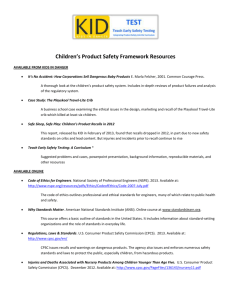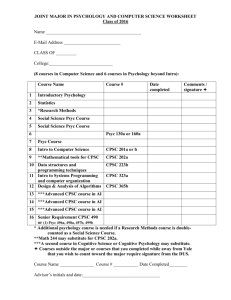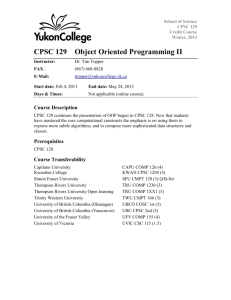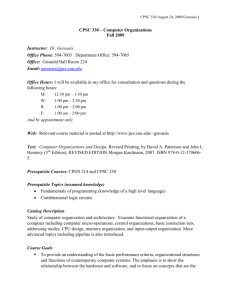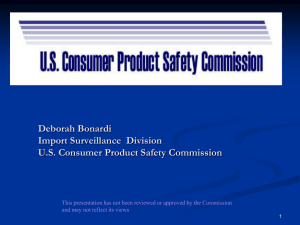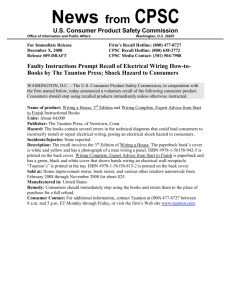CPSC Nanomaterial Statement CPSC Mission The U.S. Consumer
advertisement
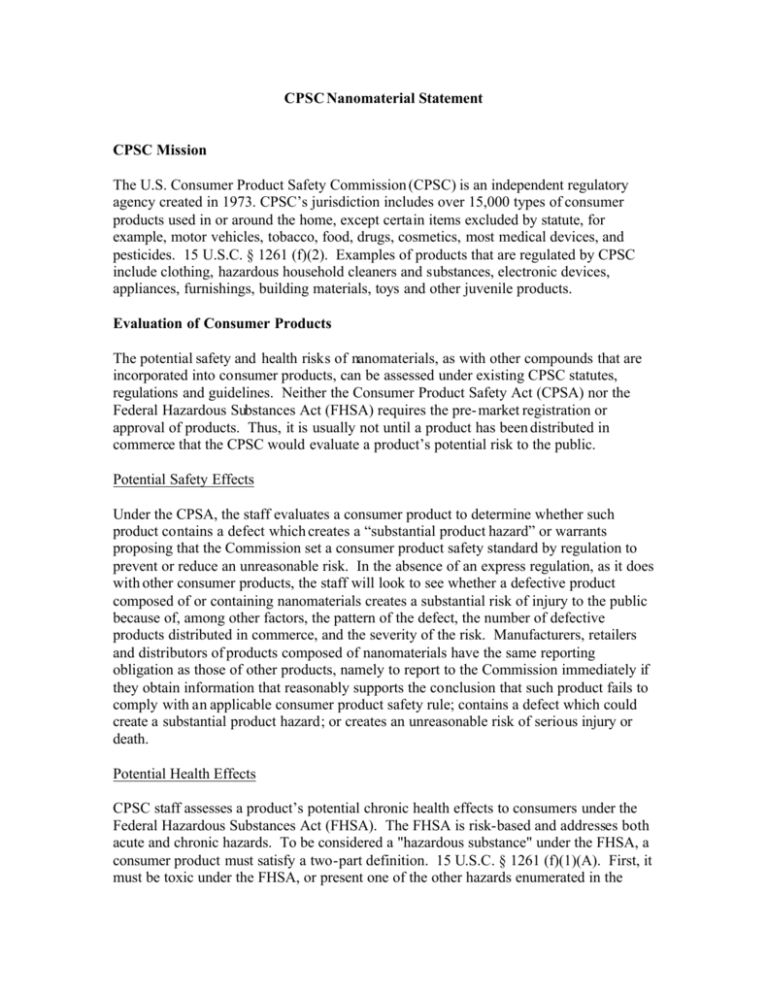
CPSC Nanomaterial Statement CPSC Mission The U.S. Consumer Product Safety Commission (CPSC) is an independent regulatory agency created in 1973. CPSC’s jurisdiction includes over 15,000 types of consumer products used in or around the home, except certain items excluded by statute, for example, motor vehicles, tobacco, food, drugs, cosmetics, most medical devices, and pesticides. 15 U.S.C. § 1261 (f)(2). Examples of products that are regulated by CPSC include clothing, hazardous household cleaners and substances, electronic devices, appliances, furnishings, building materials, toys and other juvenile products. Evaluation of Consumer Products The potential safety and health risks of nanomaterials, as with other compounds that are incorporated into consumer products, can be assessed under existing CPSC statutes, regulations and guidelines. Neither the Consumer Product Safety Act (CPSA) nor the Federal Hazardous Substances Act (FHSA) requires the pre- market registration or approval of products. Thus, it is usually not until a product has been distributed in commerce that the CPSC would evaluate a product’s potential risk to the public. Potential Safety Effects Under the CPSA, the staff evaluates a consumer product to determine whether such product contains a defect which creates a “substantial product hazard” or warrants proposing that the Commission set a consumer product safety standard by regulation to prevent or reduce an unreasonable risk. In the absence of an express regulation, as it does with other consumer products, the staff will look to see whether a defective product composed of or containing nanomaterials creates a substantial risk of injury to the public because of, among other factors, the pattern of the defect, the number of defective products distributed in commerce, and the severity of the risk. Manufacturers, retailers and distributors of products composed of nanomaterials have the same reporting obligation as those of other products, namely to report to the Commission immediately if they obtain information that reasonably supports the conclusion that such product fails to comply with an applicable consumer product safety rule; contains a defect which could create a substantial product hazard; or creates an unreasonable risk of serious injury or death. Potential Health Effects CPSC staff assesses a product’s potential chronic health effects to consumers under the Federal Hazardous Substances Act (FHSA). The FHSA is risk-based and addresses both acute and chronic hazards. To be considered a "hazardous substance" under the FHSA, a consumer product must satisfy a two-part definition. 15 U.S.C. § 1261 (f)(1)(A). First, it must be toxic under the FHSA, or present one of the other hazards enumerated in the statute. Second, it must have the potential to cause "substantial personal injury during or substantial illness during or as a proximate result of any customary or reasonably foreseeable handling or use." Therefore, exposure and the subsequent risk must be considered in addition to toxicity when assessing potential hazards under the FHSA1 . Chronic toxicity data are assessed by CPSC staff referencing CPSC’s chronic hazard guidelines in addition to reviewing available data and applying expert judgment (see 16 C.F.R. § 1500.135). CPSC staff is currently reviewing and updating the chronic hazard guidelines to address, among other things, nanomaterial use in consumer products. The first step in the risk assessment process is hazard identification, that is, a review of the available toxicity data for each substance under consideration and a determination of whether the substance meets the definition of “toxic” under the FHSA. If a substance meets that definition of toxic under the FHSA due to chronic toxicity, then a quantitative assessment of exposure and risk is performed to evaluate whether the substance may be considered a “hazardous substance” under the FHSA. If a product is considered a hazardous substance, the FHSA requires cautionary labeling to address the hazards presented by the product and the safe use, handling and storage of such product. If labeling is inadequate to protect the public, the Commission can, by regulation, ban the product. Any toy or other product intended for use by children which is a hazardous substance or contains a hazardous substance accessible to a child would generally be considered a banned hazardous substance. As stated above, the FHSA does not provide for pre-market registration or approval. This places the responsibility on manufacturers to ensure that their products are labeled as required by the FHSA. Products Made with Emerging Technologies There is a growing use of compounds or materials that have been produced using technologies (i.e., nanotechnologies) that directly manipulate matter at the atomic level and fabricate molecules and materials that could not have been produced in the past. Nanomaterials are defined as materials/particles that range from 1 to 100 nanometers (nm) in length. Although they may have the same name as a material currently in use, because of their small size, these new materials may demonstrate different physical and chemical properties. Some of these new nanomaterials are being used in consumer products with the stated purpose of improving the performance and durability of these products. Nanomaterials represent a wide range of compounds that may vary significantly in their structure, physical and chemical properties, and potentially in their behavior in the environment and in the human body. Because of the wide variation in potential health effects and the dearth of data on exposure and toxicity data of specific nanomaterials, CPSC staff is unable to make any general statements about the potential consumer exposures to, or the health effects that may result from exposure to nanomaterials during consumer use and disposal. Regulatory Challenges The introduction of consumer products containing nanomaterials into the marketplace may require unique exposure and risk assessment strategies. One of the primary data needs will be the identification of the specific nanomaterial in the consumer product. The current definition of a nanomaterial used by federal agencies specifies that the base constituent be between 1 and 100 nm in length. Identifying any potential health hazards from a specific product will require characterization of the materials to which a consumer is exposed during product use, including assessment of the size distribution of the materials released. Once the exposure has been characterized, toxicological data that is appropriate for the particle sizes represented in the exposure assessment will be used in any assessment of health risks. CPSC Nanotechnology Activities CPSC staff is involved in a number of federal and private initiatives addressing the production and use of nanomaterials. Groups that involve federal agencies include the Nanoscale Science, Engineering and Technology (NSET) and the Nanotechnology Environmental Health Issues (NEHI). These groups also foster communication between the staff of various federal agencies, including CPSC, with regulatory authority over nanomaterials, and promote the sharing of data and best available practices for the regulation of nanomaterials. Organizations that are composed of both federal and no n-federal staff include the American National Standards Institute (ANSI), ASTM International, and the International Life Sciences Institute (ILSI). The activities of these groups include promoting responsible research and development of nanomaterials that can be used in consumer products and providing information on new products that are being introduced into the market. References 1 Consumer Product Safety Commission (CPSC) (1992) Labeling requirements for art materials presenting chronic hazards; guidelines for determining chronic toxicity of products subject to the FHSA 16 CFR § 1500.135; See also Federal Register preamble and supplementary definition of “toxic” under the Federal Hazardous Substances Act. 57 Fed. Reg. 46626-46674 (1992).
